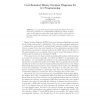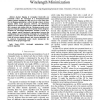42 search results - page 1 / 9 » Representational Correspondence as a Basic Principle of Diag... |
KNINVI
2005
Springer
13 years 9 months ago
2005
Springer
The timeworn claim that a picture is worth a thousand words is generally well-supported by empirical evidence, suggesting that diagrams and other information graphics can enhance h...
CVPR
2006
IEEE
14 years 6 months ago
2006
IEEE
Coarse-to-fine classification is an efficient way of organizing object recognition in order to accommodate a large number of possible hypotheses and to systematically exploit shar...
CPAIOR
2007
Springer
13 years 10 months ago
2007
Springer
Abstract. In recent work binary decision diagrams (BDDs) were introduced as a technique for postoptimality analysis for integer programming. In this paper we show that much smaller...
ICCD
2006
IEEE
14 years 1 months ago
2006
IEEE
—In-place flipping of rectangular blocks/cells can potentially reduce the wirelength of a floorplan/placement solution without changing the chip area, In a recent work [Hao 05], ...
IIE
2008
13 years 4 months ago
2008
Abstract. Learning Objects (LOs) play a key role for supporting eLearning. In general, however, the development of LOs remains a vague issue, because there is still no clearly defi...


